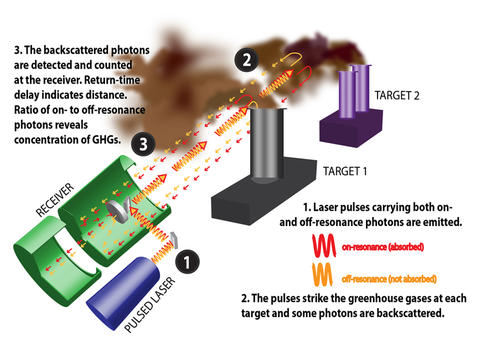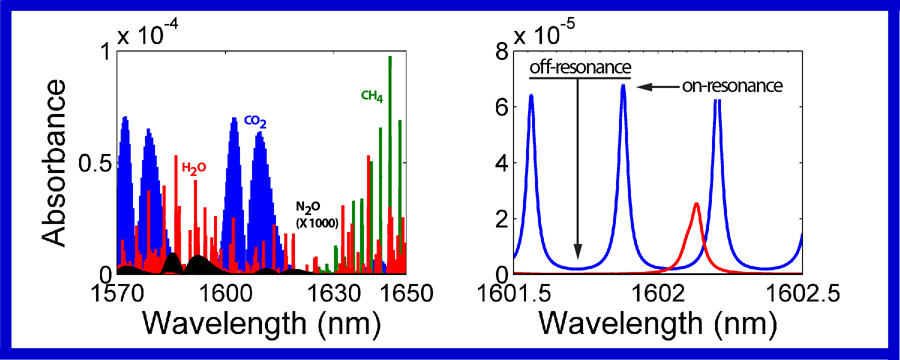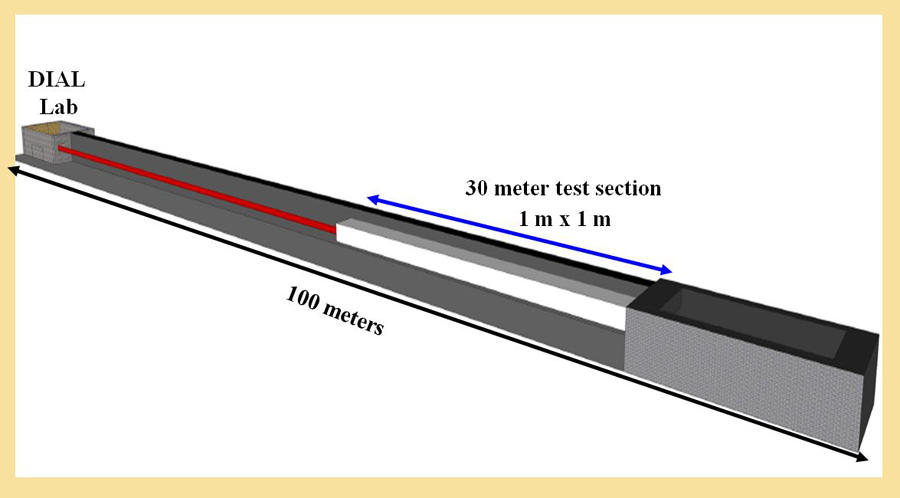
For climatologists and environmental policy makers who need to determine the flux of greenhouse gases (GHG), there are three paramount questions: Where is it, how much is there, and how is it moving? A new measurement approach is being developed and tested by a PML research team and NIST colleagues that may provide answers of unprecedented accuracy to all three.
The technique employs differential absorption LIDAR, or DIAL for short. LIDAR is the familiar acronym for "light detection and ranging" which, like lower-frequency radar, determines distance to an object by measuring the time it takes for a pulse of radiation to travel to the target and bounce back to a detector. But the NIST DIAL project will provide much more critical information. The strength of DIAL in contrast to other techniques is that a single measurement can give the concentration of gas along a line-of-sight with a resolution of a few tens of meters. With multiple measurements, a three dimensional distribution of gas can be mapped.
"Our goal," says project leader Kevin Douglass of PML's Radiation and Biomolecular Physics Division, "is new technology for transfer to the private sector with well characterized and reduced measurement uncertainties. Our long-term goals are to measure both concentration and velocity of the main greenhouse gases – carbon dioxide (CO2), methane (CH4), and nitrous oxide (N2O) – over a range of about 3 kilometers and with a resolution of about 10 meters."
The approach to reaching those goals requires a new and sophisticated laser system to illuminate a volume of GHGs in the atmosphere with bursts of light at two carefully controlled wavelengths. [See Figure 1, above.] Photons from each wavelength backscatter from aerosols and dust at the target location, and bounce back toward the DIAL apparatus. The returning photons of each wavelength are counted and their Doppler shifts are measured. The difference in the number of backscattered photons at each of the two wavelengths reveals the GHG concentration along the path, and the Doppler shift measurement allows determination of the velocity of the gas.
The technique exploits the fact that any given molecule will absorb electromagnetic radiation at only a few discrete wavelengths matching the permitted energy levels unique to its chemical species. (A photon of one of the absorbed wavelengths is said to be "resonant" with the molecule.) The absorption pattern constitutes a spectroscopic signature. The signatures of the main greenhouse gases, CO2, CH4 and N2O, are well known, allowing the experimenters to precisely select which gas they will measure.
Sending pulses (typically a few nanoseconds long) of resonant photons into the atmosphere containing the target gas will result in absorption and therefore reduced backscatter. But a photon of nearly the same wavelength, but not-resonant, will not be absorbed and will have a larger backscatter. The small difference in wavelength ensures the wavelength-dependent effects of the atmosphere are negligible
"One way DIAL is typically performed is to measure the on-resonance backscatter signal for some time and then tune the laser to measure the off-resonance signal," Douglass says. The problem is that the atmosphere may have changed between measurements. Our new system is designed to perform on-resonance and off-resonance measurements simultaneously."
All three of the principal GHGs have clearly defined absorption peaks at near-infrared wavelengths between 1.65 micrometers and 1.57 micrometers. [See Figure 2, below] That range turns out to be doubly fortunate for environmental and climate scientists. First, water vapor is only weakly absorbing in that wavelength range. "It is a happy accident that the 'water window' coincides both with the range of interest to us and with a range where eye safety risks are minimized," says team member Stephen Maxwell.

Second, 1.55 micrometers is one of the staple wavelengths used by the telecom industry because it travels with minimum dispersion in fiber-optic cable. As a result, there are numerous devices on the market optimized for wavelengths in the water window range. "The telecom revolution has provided all these components that 10 years ago you wouldn't even have thought about having – or they would have occupied the better part of a room," says James Whetstone, NIST's Special Assistant to the Director for Greenhouse Gas Measurements and a member of the DIAL team. "Before that, people had not made the investment in making the wafers that could generate the diode lasers that are key to spectroscopy in this region. But the telecom people decided to do 1.55 micrometers and then determined how to tune the laser frequency cheaply and robustly, so now you can get near-infrared lasers that go from about 1.2 micrometers down to almost 2 micrometers for not much money. Whereas it used to be that you just flat couldn't get them."
"We're pulling together some of the current state of the art, and we're trying to take the best parts of those technologies and apply them here," says team member David Plusquellic. But each element of the apparatus has to be adapted, tested, modified and re-tested for GHG measurements. For example, Douglass says, in the case of measuring wind speed, "we're currently working on determining our detection limits for measuring the Doppler shift from aerosol particles. A 2 mph wind will result in a 1 MHz Doppler shift at our wavelength. We haven't measured the shift yet, but we estimate a detection sensitivity of 5 to 10 mph will be possible with our current system. In the next-generation system under development, we'll be significantly improving on that. It's not hard to image that we'll be able to get sub-meter-per-second wind speed resolution at long range."
The team is also taking advantage of another cutting-edge component to boost the output. The initial DIAL beam is generated by a diode laser, which alone has nowhere near the power required to probe a distant volume of gas. So the team runs the laser beam into a device called an optical parametric oscillator, which increases the number of photons by approximately 109.
The group has been using a 2 meter test chamber, but is now in the process of constructing a facility 50 times larger. The DIAL system will be located in a room that connects to a 100 meter long tunnel facility in the basement of a building on NIST's Gaithersburg, MD campus. [See Figure 3] A 30 meter long section of the tunnel will have precise gas handling and flow control, and is being developed in collaboration with the PML's Sensor Science Division. This section will be equipped with a variety of sensors that will serve to validate the operation of the DIAL system and the corresponding analysis algorithms. A collaborator in NIST's Statistical Engineering Division, Daniel Samarov, is developing new analysis methods to better quantify and characterize measurement uncertainty of the DIAL system.

When fully developed, the NIST DIAL technique may have many uses beyond conventional fenceline monitoring. For example, there is considerable interest in identifying and quantifying methane emission sources to the atmosphere. "One of those sources is shale gas fields," Whetstone says. "So are natural gas distribution networks. There are a number of ways to detect methane now, but you don't get velocities and you have to take the instrument to the location. So I think there's a potential for DIAL technology to be used to map out methane releases over regions in the 5-km scale, which is roughly the size of the NIST Gaithersburg site. You can imagine putting it on top of a building and looking at both concentration and velocity to determine the greenhouse gas flux into or out of the area.
"In addition, there is a great need for ground-truth measurements to calibrate remote sensors such as those in satellites. Another potential application is to locate leaks over carbon sequestration sites. If you could put this technology on a vehicle, you could go over the site looking for CO2 vents with something like 5- or 10 meter spatial resolution. The greater the portability, the larger the number of possible uses. In my wildest dreams, the NIST DIAL equipment would fit in two suitcases and cost less than $100,000."

